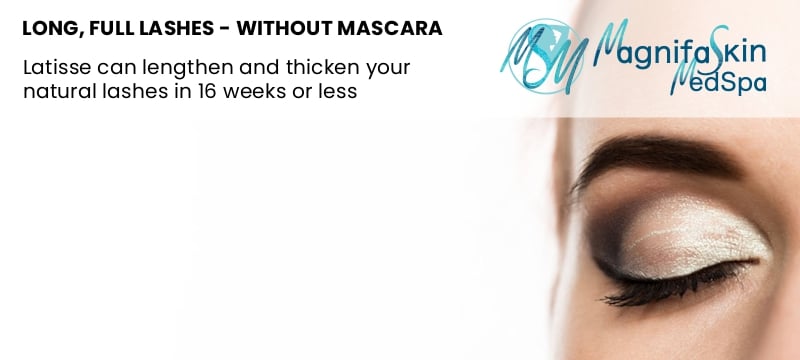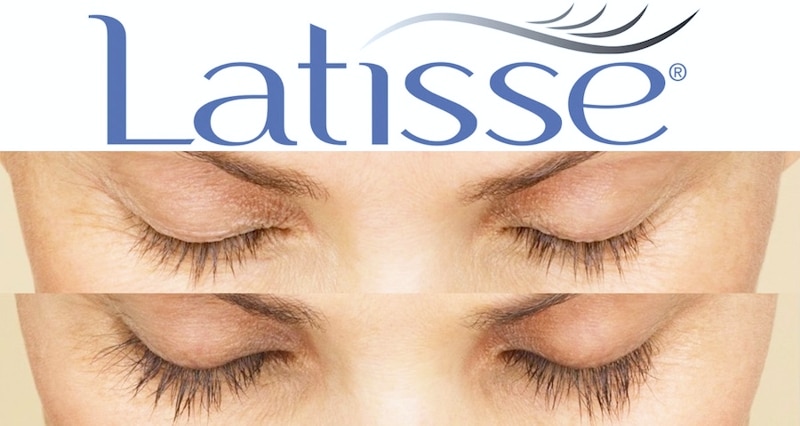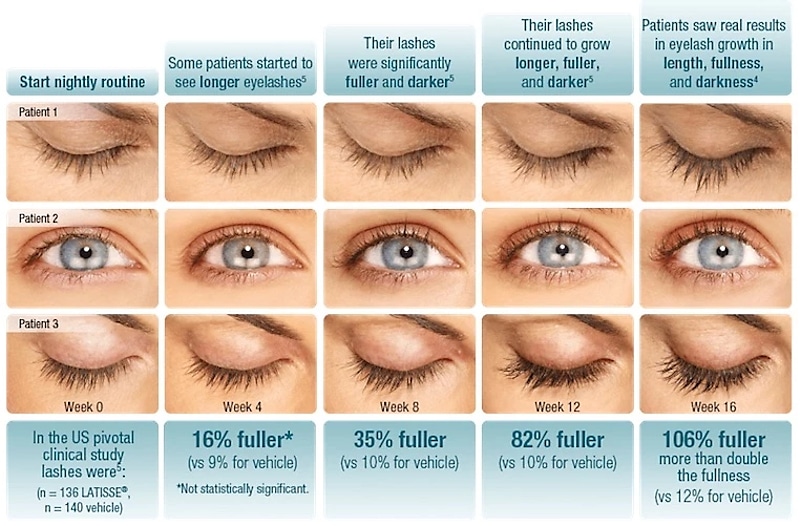Latisse
The Science of Rejuvenation


Be the first to know about new Specials, and blog posts with valuable free information on skin care, beauty and wellness. Sign up below and you'll receive an email notice of new specials as well as new posts. You can unsubscribe at any time.

Tired of applying multiple layers of mascara to get full lashes or daily applying false lashes? While extensions can give you full lashes, the effect only lasts six to eight weeks because of course your lashes are constantly falling out and being replaced with new ones. When the lash goes, so does the extension. Latisse can permanently increase the length and thickness of your lashes. In this week’s post, we’ll cover how it works, what to expect, and the possible side effects.

As you can see, Latisse can significantly improve lashes for most women. Full effect after approximately 16 weeks.
When Was Latisse Discovered?
It was discovered by accident after Allergan developed a medicated eye drop for treating ocular hypertension (pressure in the eyes – which can eventually lead to blindness). The medication was effective for reducing the pressure, and patients also noticed the unexpected side effect of longer, fuller lashes. After some refinement and testing, Latisse received FDA approval in 2008. Many women have been using it ever since to get the lashes they want, rather than the ones that nature gave them.
How Does It Work?
The truth is that even the smart folks at Allergan aren’t completely sure. They think it affects the anagen, or growth, phase of the eyelash hairs, causing that phase to extend. This results in longer lashes, and may also stimulate growth from lash follicles that have become dormant. This happens naturally with age, just as most of us will eventually experience some thinning of the hair on our head. Exactly how Latisse stimulates the anagen phase remains a mystery, though.
Latisse is applied topically along the skin of the upper lid, near the lashes. It is not an eyedrop, and you should avoid getting it in your eye.
Will It Work For Me?
The short answer is ‘probably’. Allergan conducted a clinical trial before releasing Latisse with 278 test subjects at 16 sites across the U.S. The women included in the study ranged in age from 22 to 78 and came from many different ethnic backgrounds. The study was conducted over a period of 16 weeks, and each subject’s lashes were photographed and measured every 4 weeks.
The results? 78% of women gained greater fullness and length, some of them to a dramatic degree.
It is important to note that this product is not intended for use on your lower lashes.
How Soon Will I See Results?
Most patients will begin to see noticeable results after about 4 weeks, with maximum effect after 16 weeks. You must continue to use Latisse, or eventually, the effect will fade and your lashes will return to their normal state. In most cases, however, continuing to use it daily will not be necessary. We’ll provide you with a schedule.

While Latisse doesn't work for everyone, most patients experience a significant lengthening and thickening of their lashes. You should expect to see some improvement after only a few weeks, with full effect after 16 weeks.
Do I Need a Prescription?
Yes, but after a brief assessment, Dr. Tony Cucuzzella can do that for you right here in our medical spa. You apply Latisse yourself at home. We’ll show you how to apply it safely. Don’t be concerned, however. If you do get Latisse in your eye, while it might sting a bit, it won’t hurt you or endanger your vision.
Eyelash Loss Due to Chemotherapy
If you lost your eyelashes along with your hair during chemo, Latisse has been shown to be especially effective for restoring lashes after cancer treatment.
Can I Still Use Mascara?
Of course. Latisse will eventually lengthen and thicken your natural lashes, but you can continue to enhance your lashes with mascara while using Latisse.
What Are the Risks?
Latisse does carry some risks. If you are concerned about these, you should discuss them with Dr. Cucuzzella and your family physician before using Latisse.
Darkened Skin
In rare cases, Latisse may darken the skin slightly at the border of eyelashes. This darkening is not permanent and will go away if you stop using Latisse.
Eye Color Change
Even rarer, but still a possibility, Latisse has been known to discolor the eyes of people with blue or light eye color. While this is indeed extremely rare (we’ve never seen it happen) the change is said to be permanent, so if you have very light eyes and love your natural color, you may not want to risk using Latisse.
Eye Irritation
If you have dry eyes or wear contacts, you may experience some dryness or irritation. In most cases, this can be treated with moistening eye drops.
Pregnancy
As with many medications, no one knows if Latisse may cause problems during pregnancy. Therefore, you are strongly advised not to use Latisse if you are pregnant or nursing.
Unwanted Hair Growth
Some patients have experienced unwanted hair growth or thickening of facial hairs around the eyes, however, this is rare and should only happen if Latisse is allowed to regularly run or drip on areas outside the lash line.
Eyebrows Thinning Too?
We can help with that as well. Visit our NeoGraft page to find out how we can thicken and restore your brows with the undetectable NeoGraft Hair Transplant procedure.


